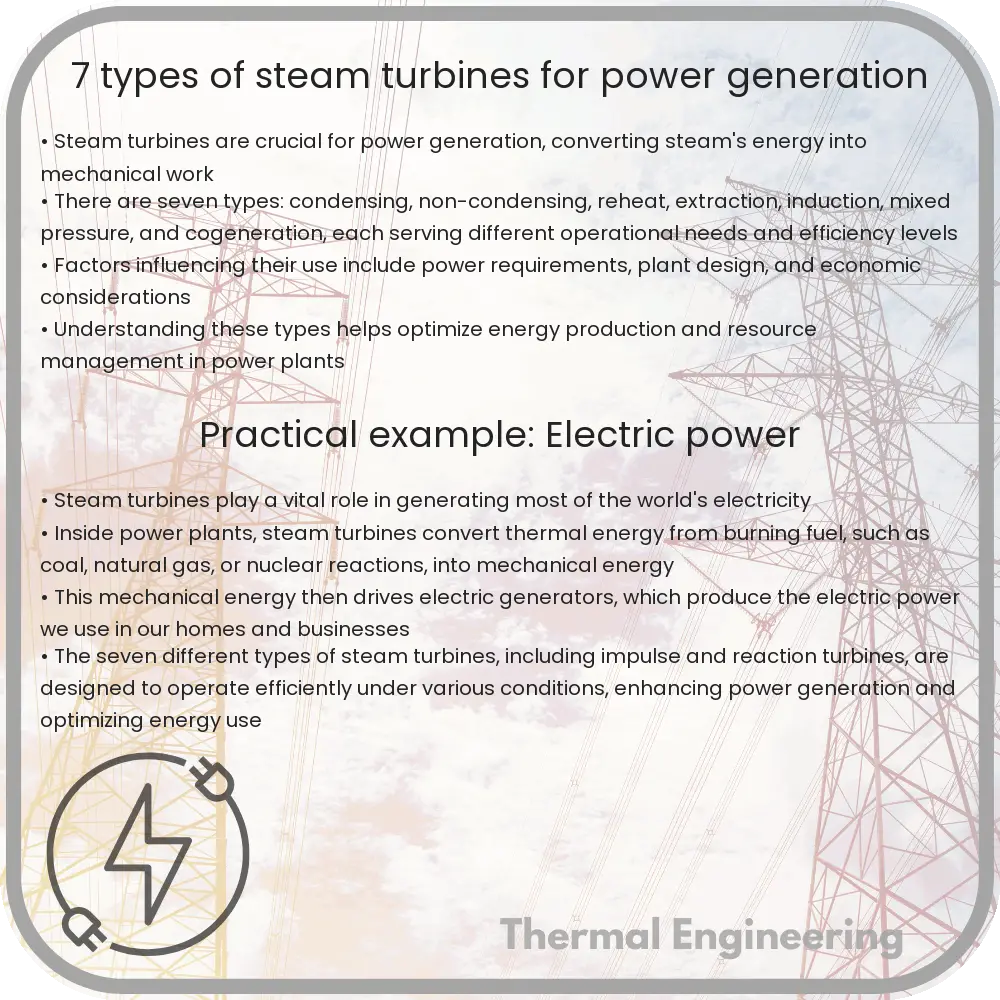Learn about the types and functions of steam turbines used in power generation, focusing on their design, efficiency, and applications.

Introduction to Steam Turbines for Power Generation
Steam turbines are a critical component in the power generation industry, converting thermal energy from steam into mechanical energy that drives generators to produce electricity. These devices harness the principles of thermodynamics and fluid dynamics to efficiently produce power in various settings, including utility-scale power plants and industrial facilities. Different types of steam turbines are designed to accommodate a range of operational needs and efficiencies. This article explores seven common types of steam turbines used in power generation.
1. Impulse Steam Turbine
The impulse steam turbine leverages the kinetic energy of high-velocity steam jets to turn the turbine blades. The steam is expanded, and its velocity is increased through a nozzle before it strikes the blades of the rotor. Impulse turbines are characterized by their simple design and are most effective at handling high pressure and low mass flow rates of steam.
2. Reaction Steam Turbine
In reaction turbines, both the rotor and the stator blades are designed to expand the steam. Unlike impulse turbines, where energy transfer occurs mainly at the stator, reaction turbines involve the expansion of steam in both the fixed and moving blades, thereby producing thrust as steam accelerates through the turbine stages. This type of turbine is generally more efficient than the impulse turbine, especially at lower pressure drops and higher flow rates.
3. Condensing Steam Turbine
Condensing steam turbines are common in power plants where high efficiency is critical. In these turbines, the exhaust steam is condensed into water by cooling in a condenser after doing its work in the turbine. This process creates a significant pressure drop, enhancing the turbine’s efficiency by allowing extraction of the maximum amount of energy from the steam.
4. Non-Condensing (Back Pressure) Steam Turbine
Non-condensing or back pressure steam turbines do not condense the exhaust steam but instead exhaust it into the process or the atmosphere at a higher pressure. These are typically used when the exhaust steam is required for process applications, such as in sugar mills, chemical plants, or district heating systems.
5. Extraction Steam Turbine
Extraction turbines allow steam to be extracted from one or more stages, at different pressures and temperatures, for use in various industrial processes, or for heating purposes. This type of turbine can optimize the generation of both electric power and thermal energy, making it a cornerstone of cogeneration or combined heat and power (CHP) systems.
6. Induction Steam Turbine
Induction turbines are somewhat less common. They can intake additional steam at intermediate stages. This feature can be utilized to adjust the power output or to incorporate steam from different sources, enhancing the flexibility in operations and overall system efficiency.
7. Reheat Steam Turbine
Reheat steam turbines feature a system where steam exits a high-pressure turbine stage, is reheated in a boiler, and then re-enters a low-pressure turbine stage. This process increases the expansion ratio without exceeding the temperature limits of the turbine blades, thus maximizing efficiency and minimizing blade wear.
Conclusion
Understanding the different types of steam turbines and their unique characteristics and applications can help in selecting the right turbine for specific power generation needs. Each type offers distinct advantages in terms of efficiency, suitability for various operational conditions, and integration with industrial processes. With advancements in technology, the role of steam turbines continues to evolve, underscoring their importance in the global energy landscape.